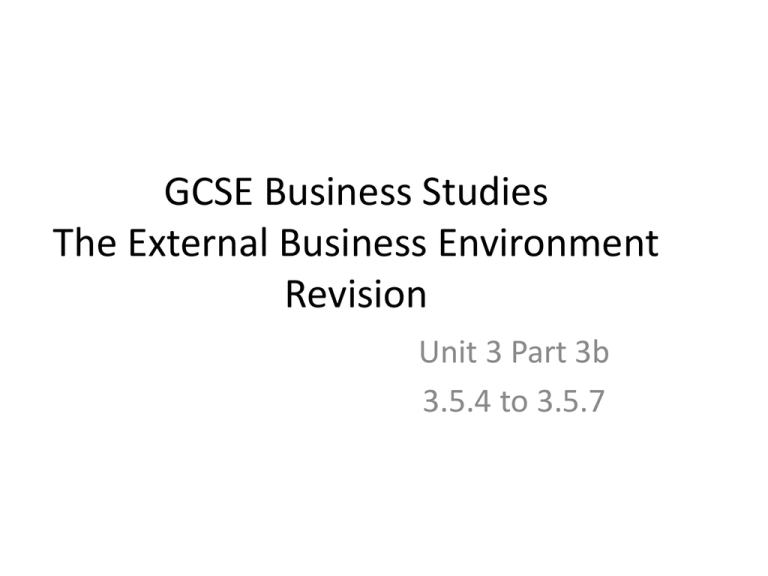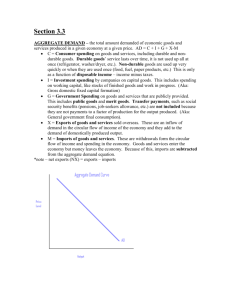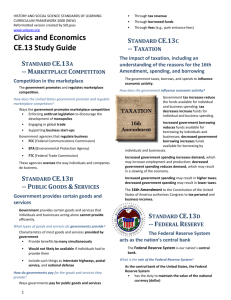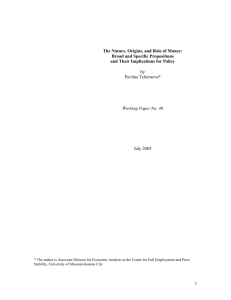GCSE Business Studies The External Business Environment Revision
advertisement

GCSE Business Studies The External Business Environment Revision Unit 3 Part 3b 3.5.4 to 3.5.7 Government and the Economy Types of Economies: Planned: Government control the production and distribution. Market: Private individuals make the majority of decisions on what to produce. Mixed: Goods and services are provided by both the private sector and the Government Managing the mixed economy In the UK there are 3 levels of Government that affect business and the economy: – Local Government—local county decision making; – Central Government—nationally elected, makes major laws about the economy; – EU Government—run from Brussels and responsible for devising some common policies such as the Social Charter and Common agricultural policy Government Objectives In the mixed economy, government makes decisions to operate efficiently. Government objectives include: ◦ ◦ ◦ ◦ Steady growth of output Low and stable inflation Low unemployment Balancing imports and exports To achieve their objectives, government uses 3 types of policies ◦ Monetary Policy—interest rates and the money supply; ◦ Fiscal Policy—taxes and government spending ◦ Supply side policies—policies aimed at increasing the production potential of the economy Fiscal Policies Changing the level of public spending and/or taxation to affect the level of demand Direct Taxes: Taxes on income: income tax, corporate taxes, national insurance contributions Indirect Taxes: Taxes on spending: VAT, and excise duties, business rates Government spending includes: public services such as the health service, roads, education and redistributing income including benefits Monetary Policy The purpose of Monetary policy is to safeguarding the value of the currency by ensuring price stability, (low inflation) and confidence in the currency. The Bank of England sets the basic interest rate to control inflation by influencing the amount of money that businesses and consumers borrow and save. Supply side Policies Spending to improve employment prospects: Education and training and other incentives to get people working harder; such as reducing the marginal tax rate. Spending to improve competition Removing restrictions/barriers to trade, removing monopolies, predatory pricing, price fixing and encouraging privatisation Spending to increasing enterprise and productivity: ◦ Grants, subsidies, reducing corporation tax Government spending and the economy Government spending, taxation and interest rates can all effect how much a business is willing to produce, (supply), and how much consumers are prepared to buy, (demand). This depends on: ◦ The amount spent or change in the rate ◦ The type of business-some goods are necessities and the amount of government spending and taxation has little affect on demand. The multiplier effect: the amount of increase or decrease in spending in the economy has a “knock-on” effect on the total spending in the economy. How government supports business: • Improving supply to enable greater competition with foreign suppliers includes: – Cutting taxes on business profits – Providing grants and subsidies to business – Cutting income tax, so consumers buy more – Education and training to improve workforce productivity – Improving infrastructure – Providing information to help businesses export their goods and services Government and the environment • Governments sometimes action to deal with externalities, (when business activity leads to costs to society such as congestion and pollution). • Government action sometimes involves making the business activity more expensive, to compensate for the loss to society. Government intervention can include: – – – – – – Taxation Rules and regulations Information, (advertising and labelling) Pollution permits, (carbon permits) Subsidies for the development of green technologies Opportunities to recycle Problems with Government intervention • Taxes imposed in one country but not another may simply encourage firms to switch production to a country that does not have the tax. • It might be considered “unethical” for developing nations such as China to take costly measures to reduce pollution that has occurred as a result of other nation’s manufacturing. • It is difficult for governments to set the appropriate level of legislation because it is difficult for governments to determine which policies are going to have the best effect and reducing the externalities. Globalisation • How businesses in different countries have become increasingly dependent on each other. Examples of globalisation include: – International trade – Production abroad – Outsourcing abroad – Multinational corporations – Global branding – Migration and immigration Benefits of globalisation Demand: • Greater consumer choice • Lower prices • More jobs—inward investment Supply • Cheaper labour • More skills • Larger market for business • Economies of scale Disadvantages of globalisation Demand Workers in developing countries may be exploited Supply: Lower profits More competition may lead to lower sales Business closure and loss of jobs Increased costs of transportation Whole Economy Pollution Loss of resources Government and international trade Protectionism • Safeguarding home markets by introducing – Tariffs: taxes on imports which add to the price making home goods seem more competitive – Quotas: restrictions on the amounts that can be imported – Technical restrictions: specifications which limit imports Results of Protectionist activities: • Retaliation: quotas set against the protectionist country • Consumer discontent: resulting from price rises, (resulting in the current party falling into disfavour) • Legal Issues: it may be illegal to set tariffs and/or quotas • Reduced efficiencies: countries may be protecting inefficient industries at home Exchange Rates • The price/value of one currency against another. • When UK exchange rates decrease, its goods and services become cheaper to other countries but the cost of imported goods rises • When UK exchange rates increase, its goods and services become more expensive to other countries but the cost of imported goods falls. Effects of Exchange rates • Exchange rate falls: Exporters benefit: goods sold to foreign countries will seem cheaper; exporters can expand through capital investment and more employment but imported goods are now more expensive. • Exchange rate rise: Exporters lose because goods appear more expensive in other countries but imports are cheaper so sales will rise and some jobs may be created. Changes in exchange rates • The effect of a change in exchange rates depends on: – The size of the rise or fall – If the cost of the import is a large or small proportion of the total costs of the business – Whether there are any substitutes for the import – Whether the cost can be passed on to the buyer. The EU and Government EU: 27 Countries aiming to co-operate on trade and social affairs. Enables free trade with member countries without tariffs or quotas and freedom of labour force movement. – Advantages: • Enables firms to sell to a larger market leading to economies of scale and cost savings. • Common standards on safety and quality. • Availability of grants and subsidies; • Social charter for workers rights • Sets environmental standards • Guarantees minimum prices for crops Key terms: EU • Single Market: a market without barriers • Social Charter: worker protection against unfair practices • CAP: common agricultural policy controls price and production levels for farming • Single currency: the use of the EURO within the EU • Euro zone: 15 countries within the EU that share a common currency, the Euro Advantages and Disadvantages of having a common currency • Advantages: – Cost savings-no exchange rate – Removes uncertainty about prices – Business confidence in shared currency • Disadvantages – Initial cost of transferring computers and machinery to Euros – Confusion regarding value – Difficult to change back











